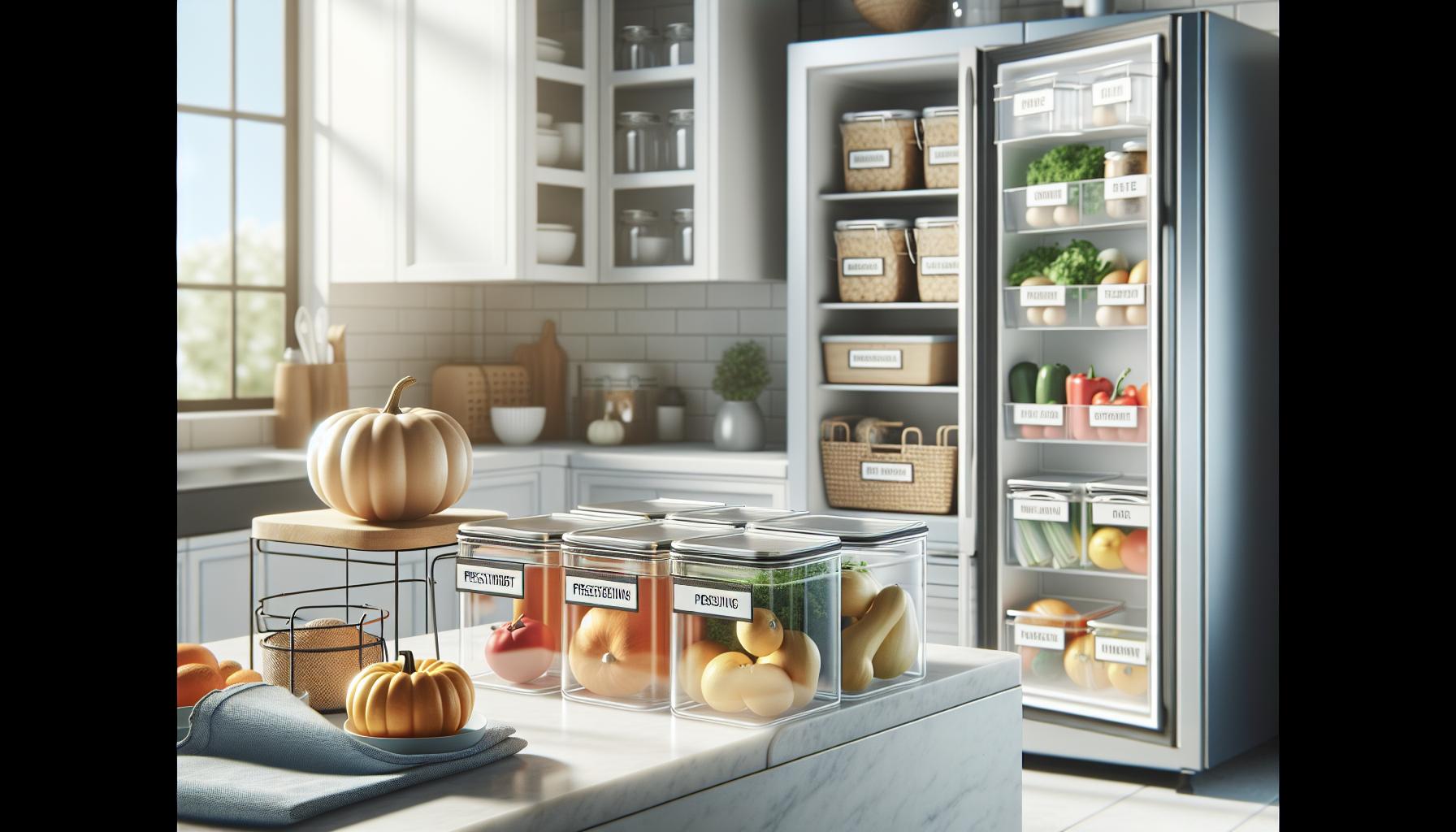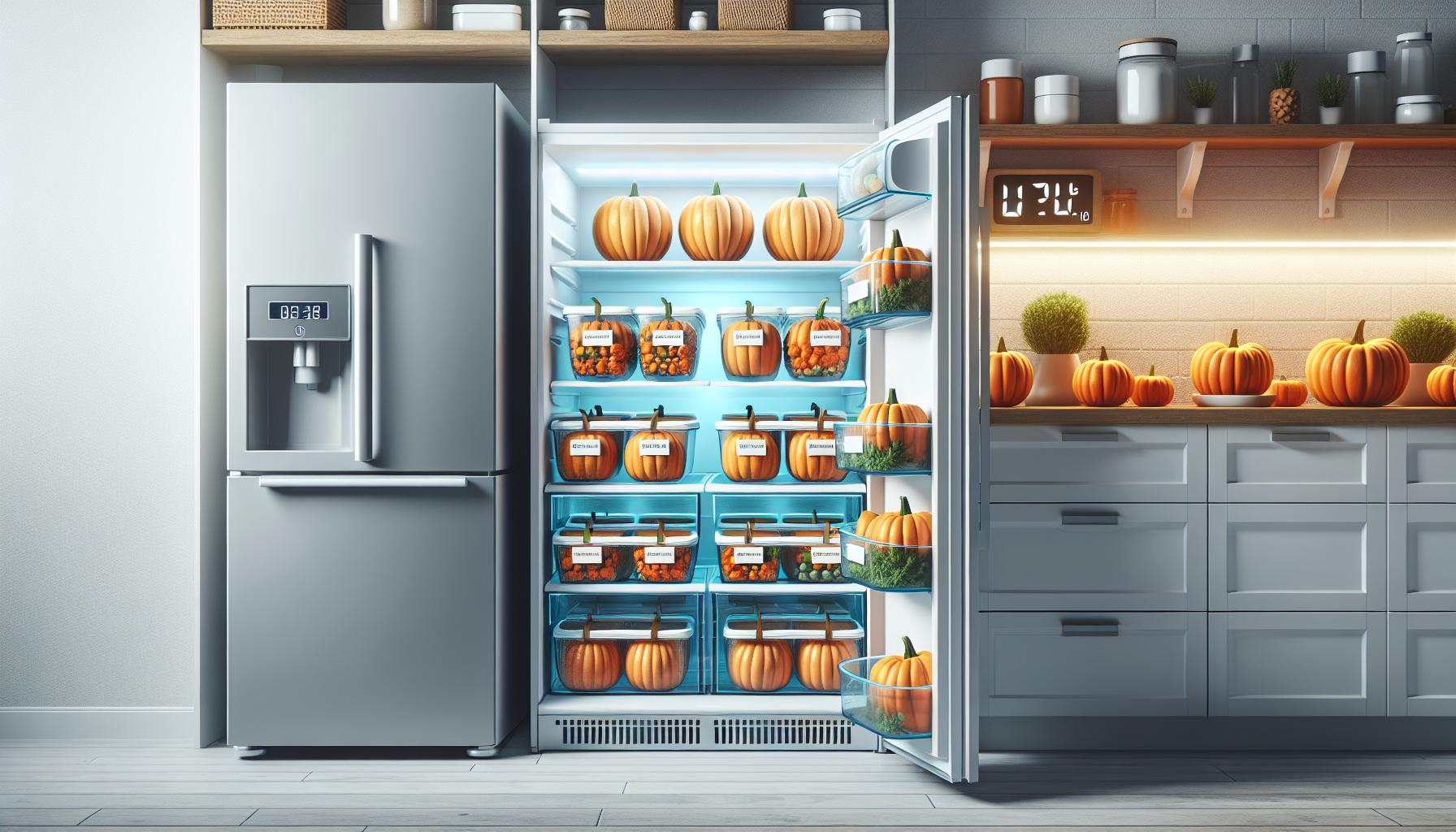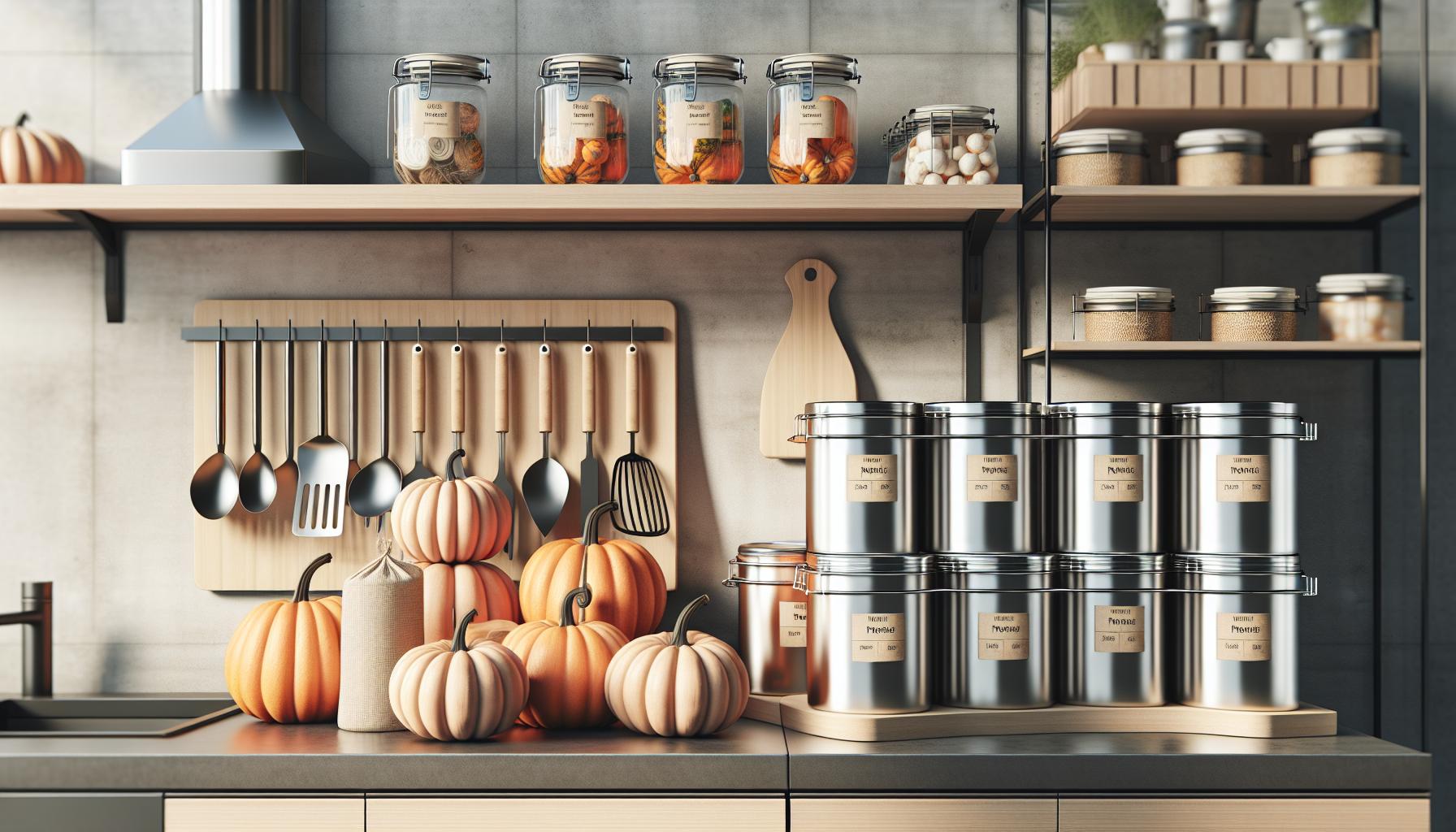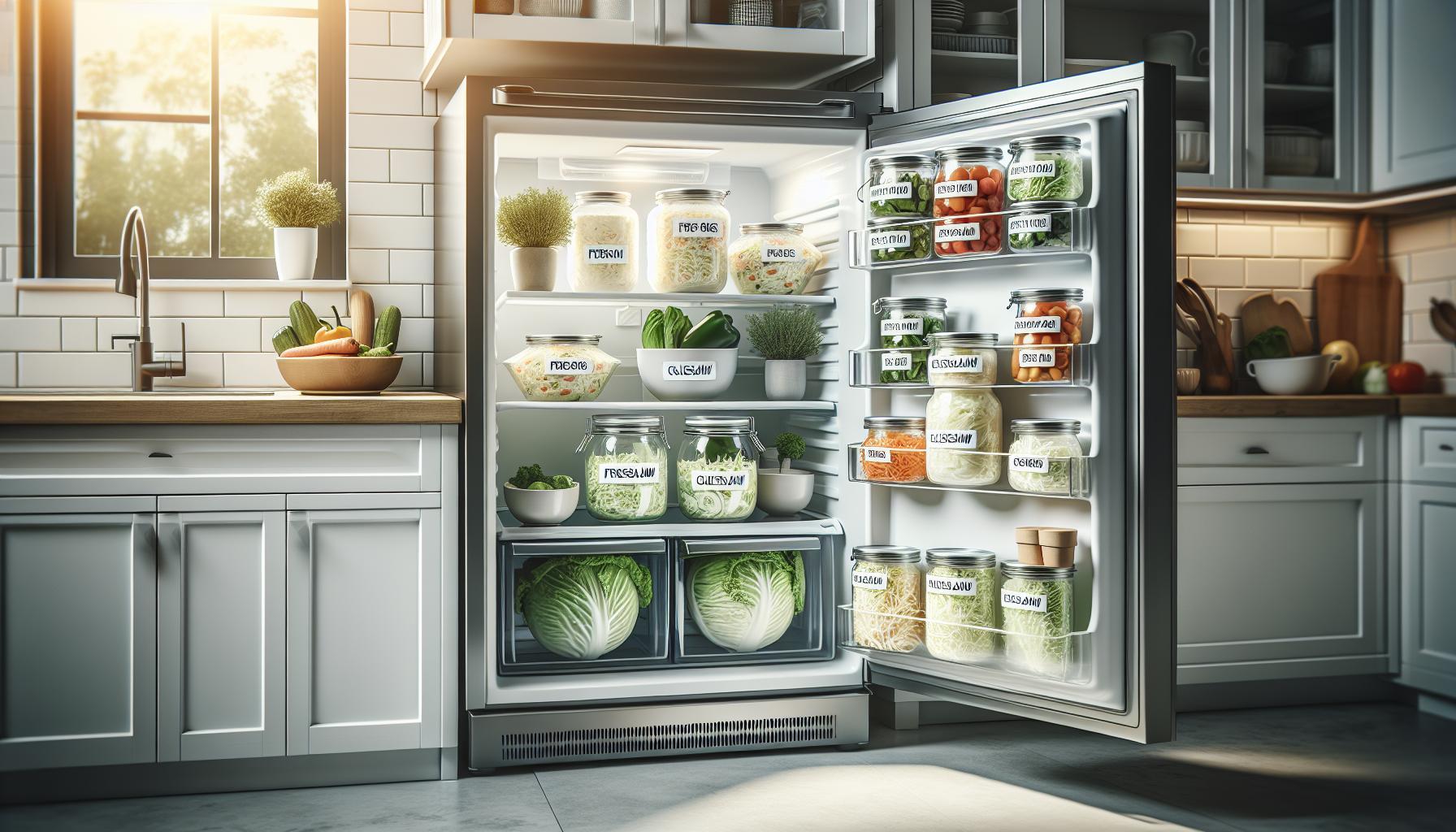Have you ever wondered how long you can keep your pumpkins outside before they deteriorate? Proper outdoor storage is crucial, especially during the fall season when pumpkins grace porches and gardens. Understanding how long pumpkins last can help you enjoy their decorative beauty and culinary potential without waste or safety concerns.
Storing pumpkins outside requires knowledge of environmental factors that can accelerate spoilage. Whether you’re preparing for Halloween festivities or planning to use your pumpkins for cooking, this guide will provide you with the essential information you need. From temperature impacts to ideal storage conditions, you’ll learn how to maximize the lifespan of your pumpkins while keeping them safe for consumption or decor.
Curious about the best practices for pumpkin storage? Read on to discover actionable tips and expert insights that will help ensure your pumpkins stay fresh longer, allowing you to make the most out of this seasonal favorite.
How Long Can Pumpkins Be Stored Outside?
Pumpkins can be a festive and versatile addition to autumnal décor and recipes, but many people wonder how long they can be stored outside before they spoil. Typically, pumpkins can last anywhere from one to three months in outdoor environments, depending on a variety of factors. Proper storage techniques and environmental conditions can greatly affect their longevity.
One critical factor that influences how long pumpkins thrive outdoors is the temperature. Pumpkins prefer temperatures between 50°F and 70°F. If exposed to extreme cold or prolonged dampness, they can begin to deteriorate much quicker. Additionally, sunlight can cause pumpkins to dry out, resulting in a shorter shelf life. For optimal results, find a shaded area that allows for airflow to keep the pumpkin fresh longer.
To maximize the storage lifespan of pumpkins, it’s important to look for pumpkins with intact skins and healthy stems. A pumpkin showing signs of fruit fly activity, soft spots, or mold indicates that it’s best to discard it quickly. On the other hand, an ideal storage environment should be cool, dry, and out of direct sunlight. Using a straw bed or wood pallets can also elevate the pumpkins off the ground, reducing moisture exposure and preventing rot from grass or wet surfaces.
In summary, while pumpkins can last a while outdoors, careful monitoring of their environment and condition is essential. Taking these steps will help you enjoy your pumpkins longer, whether for decoration or culinary use.
Factors Affecting Pumpkin Longevity Outdoors

Pumpkins are not only a seasonal delight but also a surprisingly resilient produce when it comes to outdoor storage. However, their longevity is influenced by several critical factors that can affect their quality and lifespan. Understanding these elements can help you preserve your pumpkins for a more extended period, whether for decoration or culinary use.
One significant factor impacting pumpkin longevity is temperature. Pumpkins thrive in conditions ranging between 50°F and 70°F. When exposed to extreme cold, especially below freezing, their cellular structure can break down, leading to rapid spoilage. Conversely, excessive heat can facilitate mold growth and dehydration. Sheltering pumpkins from direct sunlight and keeping them dry and well-ventilated fosters ideal conditions for preservation.
Another critical aspect is the physical condition of the pumpkin at the time of storage. Pumpkins with intact skins, firm stems, and no visible blemishes or soft spots are likely to last longer. It’s crucial to inspect your pumpkins regularly. Signs of spoilage include areas that feel soft, presence of mold, or any type of insect infestation, such as fruit flies. By discarding any affected pumpkins promptly, you can prevent the spread of decay to others.
Lastly, the environment where you place your pumpkins can significantly affect their durability. Using bedding materials like straw or wood pallets can elevate the pumpkins off the ground, minimizing their exposure to moisture, which is a key contributor to rot. Choosing a shaded area with good airflow will also help regulate temperature and humidity, further extending the life of your pumpkins. Proper attention to these factors can mean the difference between a month of display and a week of withering.
Optimal Temperatures for Pumpkin Storage

Pumpkins are surprisingly delicate when it comes to temperature, and maintaining the right conditions can significantly extend their lifespan outdoors. Ideally, pumpkins should be stored in environments where temperatures are between 50°F and 70°F. This range is crucial for keeping their cellular structure intact and preventing spoilage.
When temperatures dip below freezing, the cells within the pumpkin can rupture, causing irreversible damage and leading to rot. On the other hand, high temperatures can encourage mold growth and increase the risk of dehydration. For example, pumpkins left in direct sunlight on a hot day may develop soft spots or shrivel quickly, which compromises their quality.
To optimize pumpkin storage, it is beneficial to place them in shaded areas where airflow is abundant. Ensuring proper ventilation helps maintain an even temperature, reducing the risks associated with both heat and humidity. If outdoor conditions are unpredictable, considering portable storage solutions like shaded bins or covered containers can provide necessary shelter.
By emphasizing the importance of temperature control, you can maximize the time your pumpkins remain vibrant and fresh, prolonging their decorative beauty or culinary usability as the season progresses. Regularly monitoring the conditions in which your pumpkins are kept will certainly pay off, allowing you to enjoy them for weeks or even months.
Best Practices for Outdoor Pumpkin Storage

To keep your pumpkins looking great and lasting longer outside, there are several best practices to follow. First, always inspect your pumpkins before placing them in storage. Choose pumpkins that are firm, free of blemishes, and without any soft spots. These initial checks ensure that your pumpkins have the best chance of lasting longer outdoors.
Place your pumpkins in a shaded area with proper airflow to prevent overheating and mold growth. Direct sunlight can cause the surface of the pumpkin to soften and shrivel, while humidity can lead to rot. Positioning pumpkins away from rain, in a location that avoids pooling water, can further help protect them from moisture-related decay. A slight elevation, such as sitting them on a wooden pallet or crate, can enhance airflow and reduce contact with soil, which often harbors fungi and bacteria.
Regularly check on your pumpkins throughout their storage period. Monitor for any signs of spoilage such as discoloration or soft spots. If you notice a pumpkin starting to go bad, remove it promptly to prevent the spread of decay to other pumpkins. Cleaning your pumpkins gently with a mixture of water and vinegar can also help eliminate surface bacteria and extend their lifespan, as this natural solution discourages mold without damaging the pumpkin.
Finally, consider using breathable fabric covers or netting as additional protection against pests and extreme weather. This slight barrier can help shield your pumpkins from potential damage while still allowing them to breathe. By diligently applying these best practices, you can maximize the longevity of your pumpkins, allowing them to serve as beautiful fall decorations or delicious ingredients for weeks.
Identifying Signs of Pumpkin Spoilage

To ensure the quality and longevity of your outdoor pumpkins, being able to identify spoilage is crucial. Pumpkins can sustain their appearance and integrity for several weeks when stored properly, but various factors can accelerate spoilage. Recognizing the signs early can prevent further loss and help you maintain them as beautiful decorations or culinary ingredients.
The first signs of spoilage often manifest as discoloration or change in texture. Look for areas where the surface has become soft or mushy, as this indicates rot that can spread quickly. Bright orange pumpkins may develop dark or dull patches as they begin to decay. This may occur due to prolonged exposure to moisture or inadequate airflow around the pumpkin. Additionally, inspect the stem; a dry or withering stem can signal that the pumpkin is losing its freshness.
Another key indicator of spoilage is the presence of mold. This can appear as white, green, or black fuzzy spots on the pumpkin’s surface. Mold not only affects the aesthetic value of the pumpkin but can also compromise its internal integrity. If you notice any mold, it’s essential to act quickly-remove the affected pumpkin from storage to prevent contamination of others. Lastly, keep an eye out for pests such as insects or rodents that may also indicate spoilage and deterioration of the pumpkin’s condition.
When evaluating pumpkins for spoilage, regularly squeeze the fruit gently to gauge its firmness. A healthy pumpkin should feel solid with a firm skin. If you find a pumpkin has lost its firmness and feels unusually light, that could be a red flag for spoilage. By being proactive and vigilant in inspecting your pumpkins for these signs, you can better ensure their longevity outdoors and enjoy them throughout the season.
How to Protect Pumpkins from Weather Elements
To ensure the longevity and aesthetic appeal of pumpkins, protecting them from various weather elements is paramount. Exposure to extremes, such as intense sunlight, heavy rainfall, or frost, can significantly shorten their lifespan. One effective strategy is to place the pumpkins in a spot that receives partial shade during the hottest parts of the day. This approach helps prevent excessive drying and wrinkling of the skin, which can make them more susceptible to spoilage.
During rainy or wet conditions, consider elevating the pumpkins off the ground to reduce their exposure to moisture. Placing them on wooden pallets, crates, or stones not only keeps them dry but also ensures better airflow around the pumpkins. When dealing with the risk of frost, which can occur in cooler months, covering pumpkins with breathable fabric, such as burlap or old sheets, provides insulation while still allowing airflow. This simple action can prevent frostbite and protect their texture and firmness.
Additionally, using natural barriers such as hay or straw can create a protective layer around the base of outdoor pumpkins. These materials can cushion the pumpkins and absorb some moisture, helping to keep them dry while providing a rustic aesthetic. Always ensure that the pumpkins are arranged with adequate space between them, which helps airflow and prevents the buildup of humidity that can lead to mold growth.
In assessing overall weather conditions regularly, take proactive measures. For example, if a storm is forecast, consider bringing the pumpkins into a garage or covered porch temporarily. This flexibility can greatly enhance the chances of preserving your pumpkins for weeks, even months, while still enjoying their charm in your outdoor decor.
Storage Solutions for Longer Lasting Pumpkins
To maximize the lifespan of pumpkins stored outdoors, effective storage solutions are critical. Consider that whole pumpkins can last from one to three months outside, depending on their condition and the environment. Using the right techniques can significantly extend their freshness and attractiveness.
One well-known method is to create a breathable environment for your pumpkins. This can be achieved by elevating them off the ground using wooden pallets or crates. Not only does this prevent moisture from seeping in, but it also promotes airflow around the pumpkins, reducing the chances of mold development. Placing the pumpkins in a shaded area during the peak sun hours will also minimize the exposure to excessive heat, which can accelerate spoilage.
Moreover, implementing a protective layer of straw or hay around the base can offer cushioning and moisture absorption, enhancing the integrity of the pumpkins. Regularly inspecting them for any signs of decay, such as soft spots or discoloration, is essential. If you notice any imperfections, you can eat or cook with them while they are still suitable.
For additional care, consider devising a temporary shelter during adverse weather conditions. If inclement weather is predicted, bringing your pumpkins indoors for a short period can preserve their quality. With these proactive strategies, you can enjoy your pumpkins longer, whether for decoration or delicious recipes.
Creative Uses for Imperfect Pumpkins
In a perfect world, pumpkins would stay pristine for their entire outdoor lifespan, which can range from one to three months. However, as they begin to show signs of imperfection-like nicks or soft spots-they can still offer plenty of value. Instead of discarding those less-than-perfect pumpkins, consider these creative uses that not only address waste but also add fun and flavor to your fall season.
One option is to transform imperfect pumpkins into delicious homemade recipes. Pumpkins that are slightly blemished but still sound can be pureed for soups, pies, or purees. Cooking with these pumpkins not only reuses them but also provides an opportunity to experience the fresh, bold flavors that store-bought canned pumpkin lacks. Recipes such as pumpkin bread, muffins, or hearty pumpkin chili are simple ways to utilize these beauties. Just be sure to remove any spoiled sections before cooking.
Another innovative use is crafting. Pumpkins with minor imperfections can become decorations that last throughout the fall. Consider painting or carving designs into them; this can camouflage blemishes and create unique, personalized autumn decor. You might also use them in outdoor arrangements or as part of a cornucopia centerpiece, where their rustic appeal can shine without the need for perfection.
Lastly, if your pumpkins are beginning to rot or are no longer suitable for consumption, the compost pile is a great final destination. Rather than throwing them in the trash, converting them into compost helps enrich your garden soil for next season’s crops. Ensuring everything is adequately broken down will return valuable nutrients back to the earth, reinforcing sustainability practices.
By creatively utilizing imperfect pumpkins, you not only minimize waste but also embrace a spirit of resourcefulness that can enhance your autumn experience through cooking, crafting, and gardening.
The Best Varieties of Pumpkins for Outdoor Storage
Certain pumpkin varieties are better suited for outdoor storage than others, ensuring they remain fresh longer and withstand the elements more effectively. Among these, the Sugar Pie Pumpkin stands out for its dense flesh and small size, making it less prone to rotting compared to larger types. Its high sugar content also benefits recipes, retaining great flavor even after weeks of storage.
Cinderella Pumpkins, with their striking appearance and robust skin, are another excellent option. These pumpkins not only add a decorative flair to outdoor settings but also boast considerable durability against weather changes. The thicker rind helps protect the flesh from pests and environmental stress.
For those looking to maximize longevity, consider Long Island Cheese Pumpkins. Known for their flattened shape and sturdy skin, they can last up to several months when stored properly. Their ability to maintain freshness translates into versatile cooking options, from pies to soups, well after the autumn season.
When selecting pumpkins for outdoor storage, look for the following characteristics:
- Thick Rinds: Varieties with robust, thick skins are less likely to succumb to rot.
- Compact Sizes: Smaller pumpkins often manage better outdoors due to reduced exposure to moisture and pests.
- Healthy Stems: A pumpkin with a sturdy stem is an indicator of freshness and longevity.
In conclusion, selecting the right variety is crucial for outdoor pumpkin storage. By choosing resilient types like Sugar Pie, Cinderella, and Long Island Cheese pumpkins, you can extend their shelf life and keep your decorations vibrant well into the season, allowing for both decorative and culinary uses as the weeks progress.
Tips for Preparing Pumpkins for Storage
Before storing pumpkins outdoors, proper preparation is crucial to maximizing their lifespan and maintaining their quality. One of the first steps is to ensure that the pumpkins are harvested or selected when they are ripe. Look for pumpkins with a firm skin, a rich color, and a sturdy stem, as these indicators suggest optimal freshness and resilience. A pumpkin should be harvested or bought only after the first hard frost is expected, which can harm the quality and longevity of the fruit.
Once you have the perfect pumpkins, it’s vital to clean them properly. Use a damp cloth or sponge to wipe away any dirt and debris from the surface. This not only improves their appearance but also helps prevent mold growth during storage. It’s essential to examine the pumpkins closely for any blemishes or soft spots; these imperfections can accelerate spoilage. If you find any questionable areas, consider trimming them lightly to halt any potential decay.
Providing Protection
After cleaning, consider applying a light coat of vegetable oil or a commercial wax to seal the skin. This practice helps to lock in moisture and creates a barrier against pests and environmental factors. Ensure you reapply the oil every few weeks if the pumpkins remain outdoors, especially during periods of heavy rain or harsh sun. Additionally, placing pumpkins on a flat, dry surface or using straw or wooden pallets can prevent rot by keeping them elevated and allowing airflow beneath.
Storage Environment
Finally, position your pumpkins in a cool, shaded area, away from direct sunlight and extreme weather conditions. Ideal temperatures for outdoor storage should range between 45°F to 60°F (7°C to 15°C). Always keep an eye on the condition of your pumpkins while they’re stored outside. Regular inspections can help catch any early signs of spoilage-small, soft spots or a change in color-which can lead to larger issues if unnoticed. Preparing pumpkins thoughtfully will allow you to enjoy their decorative and culinary benefits throughout the season.
When to Bring Pumpkins Indoors for Safety
As the outdoor temperatures begin to drop or when severe weather predictions arise, it’s essential to know when it’s time to bring your pumpkins indoors for safety. Pumpkins can only withstand a limited amount of cold, moisture, and other environmental stressors before they begin to deteriorate. A good rule of thumb is to bring them inside if temperatures are expected to fall below 45°F (7°C), as prolonged exposure to cold can compromise their structure and freshness.
Additionally, if forecasts indicate heavy rain or strong winds, it is prudent to relocate your pumpkins. Even the most robust pumpkins can succumb to mold and rot if they remain saturated with excessive water or are knocked about by harsh winds. Early signs to watch for include soft spots forming on the skin or changes in color. While some pumpkins can appear perfect on the outside, persistent moisture can lead to decay quickly, so visual checks should be routine as chilly or wet conditions approach.
Another key consideration is the lifespan of your pumpkins. While varieties differ, most decorative pumpkins maintain their quality for around 8 to 12 weeks when stored correctly outdoors. If you notice they are nearing the six-week mark or are starting to exhibit signs of wear, it might be time to move them indoors, especially before the onset of harsher winter weather. They can comfortably reside in a cool, dry location inside your home, far from direct sunlight, extending their life for decorative purposes or cooking.
To summarize, keep an eye on weather forecasts and pumpkin conditions regularly. Bringing your pumpkins indoors prior to extreme temperature drops or wet conditions can help ensure they stay fresh and ready for all your seasonal festivities. Regular inspection and preemptive action will safeguard their quality and appearance, maximizing enjoyment from your outdoor harvest.
The Ultimate Pumpkin Preservation Checklist
To maximize the life and quality of your pumpkins, a proactive approach to preservation is essential. Utilizing a dedicated checklist can help ensure that your pumpkins remain fresh for as long as possible, whether for decoration or culinary use. Below are critical factors to consider in your ultimate pumpkin preservation strategy.
- Inspect Regularly: Conduct visual checks at least once a week. Look for soft spots, discoloration, or any signs of decay that may indicate spoilage.
- Optimal Storage Conditions: Aim for temperatures consistently above 45°F (7°C) and below 75°F (24°C). Humidity should also be low to prevent mold.
- Dry and Clean Surface: Before storing, ensure your pumpkins are dry and clean. Wipe them with a soft cloth to remove dirt and moisture, as excess wetness can lead to rot.
- Strategic Placement: Store pumpkins in a cool, dry location away from direct sunlight and heat sources, such as heating vents, which can accelerate decay.
- Aerate Storage: Avoid placing pumpkins directly on the ground. Opt for a wooden pallet or hay to allow air circulation, which helps prevent moisture buildup.
- Monitor Weather Conditions: Stay informed of local weather forecasts. If heavy rain or frost is predicted, bring your pumpkins inside or cover them to safeguard against damaging elements.
- Know When to Move Indoors: If temperatures dip below 45°F (7°C) or if you notice any spoilage signs, move your pumpkins indoors immediately to avoid further deterioration.
- Utilize for Cooking: Pumpkins that show wear but are still safe to eat can be cooked into soups, purees, or baked goods, ensuring no part goes to waste.
By following these guidelines, you can significantly extend the life of your pumpkins, ensuring they can be enjoyed for weeks. Remember, a little attention during storage can lead to a more rewarding fall experience.
Frequently asked questions
Q: How can I tell if a pumpkin is still good to eat?
A: To determine if a pumpkin is still good, check for soft spots, cracks, or mold on the skin. A healthy pumpkin should feel firm and have a hard shell. If it starts to smell bad or has an unusually soft texture, it’s best to discard it.
Q: What type of pumpkin lasts the longest outside?
A: Varieties such as Sugar Pie pumpkins and Long Island Cheese pumpkins tend to last longer outside due to their thicker skins and denser flesh. These factors help them withstand outdoor conditions better than thinner-skinned varieties like Jack-o’-lanterns.
Q: Is there a specific temperature range for storing pumpkins outdoors?
A: Yes, the ideal temperature range for outdoor pumpkin storage is between 50°F and 70°F (10°C to 21°C). Keeping pumpkins within this range will help prolong their freshness and prevent spoilage due to extreme temperatures.
Q: Can I cover my pumpkins for outdoor storage?
A: Yes, covering pumpkins with burlap or a breathable cloth can protect them from harsh weather elements like frost, direct sunlight, and rain. This can extend their longevity outside while still allowing for air circulation.
Q: How long can carved pumpkins last outside?
A: Carved pumpkins typically last only 5-10 days outside, depending on the weather. Warmer temperatures and exposure to moisture can speed up spoilage. To extend their life, keep them in a cool, shaded area and consider applying a preservation solution.
Q: Should I water pumpkins while they are stored outside?
A: It’s not necessary to water stored pumpkins, as moisture can promote mold growth. Instead, keep them clean and dry. If stored correctly, they will thrive without additional water during outdoor storage.
Q: When should I bring my pumpkins indoors for safety?
A: Bring pumpkins indoors when temperatures drop below 32°F (0°C) to avoid frost damage. Additionally, if rain or excessive mud is forecasted, it’s wise to move them inside to prolong their shelf life.
Q: What are some creative ways to use pumpkins that are beginning to spoil?
A: Pumpkins that show signs of spoilage can be used for composting, or you can incorporate them into recipes like pumpkin soup or puree. Creative crafts, such as using the flesh for animal feed or crafting with the seeds, are also great options.
Concluding Remarks
Now that you know how long pumpkins last outside and the best practices for their storage, you can ensure your pumpkins stay fresh and visually appealing throughout the season. Don’t wait too long-implement these storage tips today to maximize the life of your pumpkins! Whether you’re looking to create Halloween decorations or delicious recipes, understanding how to care for your pumpkins is key.
For further insights, check out our guides on pumpkin recipes or how to carve pumpkins safely to enhance your fall festivities. Engage with us in the comments below; we’d love to hear your experiences and tips on keeping pumpkins fresh. Subscribe to our newsletter for more expert advice and seasonal inspirations, ensuring this season is both fun and flavorful!





